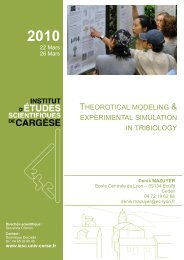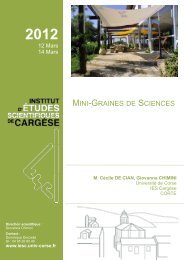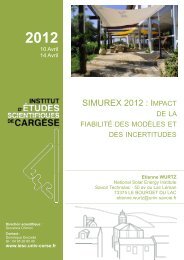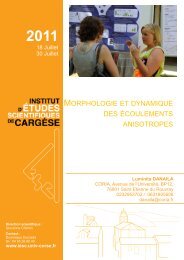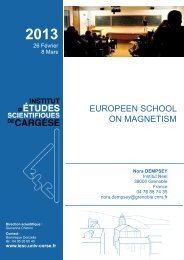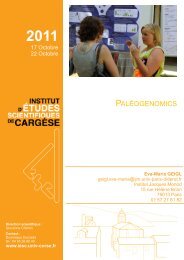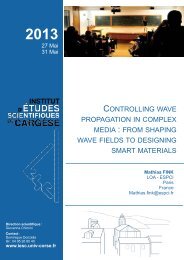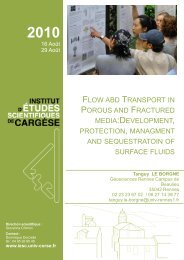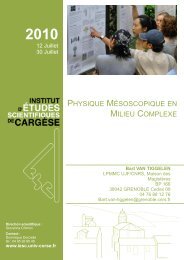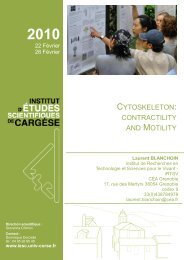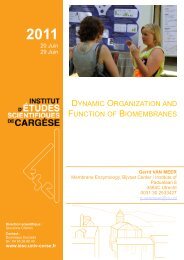nanoelectronics - Institut d'Études Scientifiques de Cargèse (IESC)
nanoelectronics - Institut d'Études Scientifiques de Cargèse (IESC)
nanoelectronics - Institut d'Études Scientifiques de Cargèse (IESC)
You also want an ePaper? Increase the reach of your titles
YUMPU automatically turns print PDFs into web optimized ePapers that Google loves.
Monday<br />
[2] U. Sivan and Y. Imry, Phys Rev B33, 551 (1986)<br />
[3] Y. Imry and A. Amir, The localization transition at finite temperatures: electric and thermal<br />
transport, in 50 years of An<strong>de</strong>rson Localization, edited by E. Abrahams (World Scientific,<br />
Singapore, 2010) in press, arXiv:1004.0966<br />
[4] O. Entin-Wohlman, Y. Imry and A. Aharony, Three-terminal thermoelectric transport<br />
through a molecular junction, Phys. Rev. B 82, 115314 (2010); R.Sanchez and M.Büttiker,<br />
ibid. 83, 085428 (2011); J-H Jiang, O. Entin-Wohlman and Y. Imry, Phys Rev B 85, 075412<br />
(2012), and to be published.<br />
[5] J-H Jiang, O. Entin-Wohlman and Y. Imry, in preparation<br />
__________________________________________________________________________<br />
Exact solution of a Levy walk mo<strong>de</strong>l for anomalous heat transport<br />
Keiji Saito<br />
Physics Department, Keio University<br />
Based on results obtained from a large number of numerical simulations and various<br />
analytical approaches it is now believed that Fourier's law is not valid in one and two<br />
dimensional mechanical systems (in particular mo<strong>de</strong>ls where momentum is conserved) and<br />
heat conduction is anomalous. Anomalous behavior in heat conduction is not only a<br />
theoretical issue but recently of experimental relevance in several low-dimensional material<br />
such as carbon-nanotube, and Graphene. Indicators of the anomaly inclu<strong>de</strong> | (i) in steady<br />
states the <strong>de</strong>pen<strong>de</strong>nce of the heat current J on system size L shows the scaling behavior , (ii)<br />
the temperature profiles across systems in nonequilibrium steady states are found to be<br />
nonlinear even for very small applied temperature diferences and, (iii) the spreading of heat<br />
pulses in anharmonic chains is superdiusive. The Levy-walk mo<strong>de</strong>l is known to provi<strong>de</strong> a<br />
good <strong>de</strong>scription of anomalous heat conduction in one-dimensional systems. In this mo<strong>de</strong>l<br />
the heat carriers execute Levy-walks instead of normal diffusion as expected in systems<br />
where Fourier's law holds. Here we calculate exactly the average heat current, the large<br />
<strong>de</strong>viation function of its fluctuations and the temperature profile of the Levy-walk mo<strong>de</strong>l<br />
maintained in a steady state by contact with two heat baths (the open geometry) [1]. We find<br />
that the current is nonlocally connected to the temperature gradient. As observed in recent<br />
simulations of mechanical mo<strong>de</strong>ls, all the cumulants of the current fluctuations have the<br />
same system-size <strong>de</strong>pen<strong>de</strong>nce in the open geometry. The case of the ring geometry is also<br />
discussed.<br />
[1] Abhishek Dhar, Keiji Saito and Bernard Derrida, arXiv:1207.1184<br />
__________________________________________________________________________<br />
Experiments on the distribution of dissipation in electron tunneling<br />
Jukka Pekola<br />
Aalto University, Helsinki, Finland<br />
I discuss work, heat and fluctuation relations in single-electron tunneling driven by a gate<br />
voltage. Our experiments confirm the validity of the most common fluctuation relations un<strong>de</strong>r<br />
isothermal conditions. I discuss a feed back mechanism by which information can be<br />
converted into energy stored in a capacitor in a single-electron circuit. Finally I propose a<br />
measurement of work in a quantum system using a calorimetric <strong>de</strong>tection.



